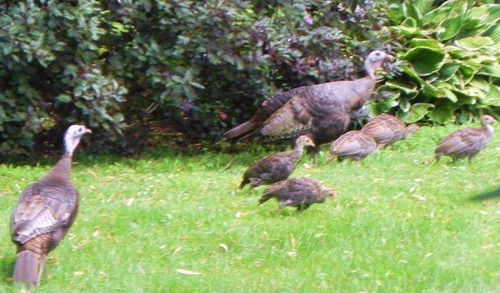 Late one afternoon in early August, a flock (the correct word is rafter) of turkeys came strolling casually across our back lawn as if they owned the place.
Late one afternoon in early August, a flock (the correct word is rafter) of turkeys came strolling casually across our back lawn as if they owned the place.
By Paul Hicks
 Late one afternoon in early August, a flock (the correct word is rafter) of turkeys came strolling casually across our back lawn as if they owned the place. In a sense they did have prior rights, since their ancestors resided here long before ours arrived.
Late one afternoon in early August, a flock (the correct word is rafter) of turkeys came strolling casually across our back lawn as if they owned the place. In a sense they did have prior rights, since their ancestors resided here long before ours arrived.
Those turkey ancestors fed a lot of Native Americans and colonists, but the breed had almost become extinct by the 1930s due to hunting and habitat loss. Then, a program of reintroduction was begun about 40 years ago in New York and other states, which has been almost too successful, as indicated by our casual backyard visitors.
Nonetheless, it is not every day that you get to be hosts to the species that Benjamin Franklin unsuccessfully promoted as our National Emblem instead of the bald eagle. Franklin wrote his daughter: “For in Truth the Turkey is in Comparison a much more respectable Bird, and withal a true original Native of America… He is besides, though a little vain & silly, a Bird of Courage, and would not hesitate to attack a Grenadier of the British Guards who should presume to invade his Farm Yard with a red Coat on.”
Our flock, which consisted of two hens and five poults, as the little ones are called, decided to stay for more than a week when they found enough food (near the bird feeder and around the lawn), shelter (between the fence and the bushes) and a roosting place to spend the night (in a large spruce tree).
At dusk on their first day, as the last of the summer’s fireflies lit up and the bats were doing fly-bys, it was fascinating to watch one hen take off in her labored flight to roost in the spruce tree. After her poults mustered enough courage, they followed her. The process was then repeated by the other hen and her brood. How they all managed to perch through the night seemed a minor miracle.
 Apparently, young wild turkeys can fly short distances a few weeks after hatching. Our poults, however, preferred to run for cover at the slightest cause for alarm, except on one occasion when our dog, let out by mistake, chased them into the spruce. Domestic turkeys have a reputation for being dumb and pathetic (as in “you’re a turkey”), but their wild cousins, especially the poults, are very alert and wary.
Apparently, young wild turkeys can fly short distances a few weeks after hatching. Our poults, however, preferred to run for cover at the slightest cause for alarm, except on one occasion when our dog, let out by mistake, chased them into the spruce. Domestic turkeys have a reputation for being dumb and pathetic (as in “you’re a turkey”), but their wild cousins, especially the poults, are very alert and wary.
They coexisted easily with the other wildlife in the garden, even when they were competing with our white squirrel for seeds under the bird feeder or sharing the lawn with the groundhogs and rabbits. Fortunately, the flock had gone foraging elsewhere when a sharp-shinned hawk landed on the lawn one day and again when a red-tailed hawk appeared a few days later.
As special as our brief encounter with wild turkeys was, it did not come close to the experience of a naturalist in the Florida pinewoods who spent more than a year “mothering” a flock of 14 wild turkey poults, raising them from hatchlings to “jennies” and “jacks” and on to hens and gobblers.
The story of this extraordinary bonding between a man and his brood of turkeys first appeared as a book, “Illumination in the Flatwoods,” by Joe Hutto, which is available in paperback. It was then made into a film as part of the “Nature” series and was shown on PBS in 2011.
The video, renamed “My Life as a Turkey,” is a fascinating, even thought-provoking documentary of Hutto’s nonstop role as a mother hen turkey. Even though we were sorry to see our young turkeys leave, they at least had two attentive hens to lead and protect them. Our regrets were nothing like the emotions Hutto felt when his flock dispersed into the wild. By then he felt so much a part of his flock that “smooth green grasshoppers had begun to look appetizing.” You can buy the video or find it on the PBS website and watch it for free.















